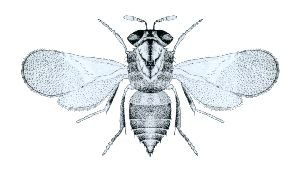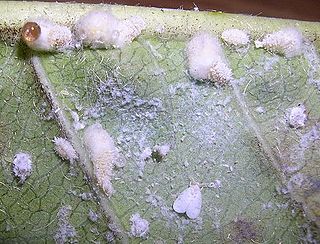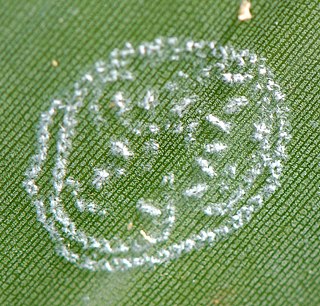
Whiteflies are Hemipterans that typically feed on the undersides of plant leaves. They comprise the family Aleyrodidae, the only family in the superfamily Aleyrodoidea. More than 1550 species have been described.

The silverleaf whitefly is one of several species of whitefly that are currently important agricultural pests. A review in 2011 concluded that the silverleaf whitefly is actually a species complex containing at least 40 morphologically indistinguishable species.

The hymenopteran family Platygastridae is a large group of exclusively parasitoid wasps, mostly very small (1–2 mm), black, and shining, with geniculate (elbowed) antennae that have an eight-segmented flagellum. The wings sometimes lack venation, though they may have slight fringes of setae.

Parasitoid wasps are a large group of hymenopteran superfamilies, with all but the wood wasps (Orussoidea) being in the wasp-waisted Apocrita. As parasitoids, they lay their eggs on or in the bodies of other arthropods, sooner or later causing the death of these hosts. Different species specialise in hosts from different insect orders, most often Lepidoptera, though some select beetles, flies, or bugs; the spider wasps (Pompilidae) exclusively attack spiders.

The Aphelinidae are a moderate-sized family of tiny parasitic wasps, with about 1100 described species in some 28 genera. These minute insects are challenging to study, as they deteriorate rapidly after death unless extreme care is taken, making identification of most museum specimens difficult. The larvae of the majority are primary parasitoids on Hemiptera, though other hosts are attacked, and details of the life history can be variable. Males and females may have different hosts and different life histories.

Aonidiella aurantii or red scale is an armored scale insect and a major pest of citrus. It is thought to be a native of South China but has been widely dispersed by the agency of man through the movement of infected plant material. In the United States it is known as California red scale. It was first found in California between 1868 and 1875, apparently brought there on planting material imported from Australia.

Encarsia formosa is a species of chalcidoid wasp and a well known parasitoid of greenhouse whitefly, one of the first to be used commercially for biological pest control, from the 1920s. They can use at least 15 species of whitefly as a host, including Bemisia tabaci and Aleyrodes proletella.

Encarsia perplexa is a tiny parasitic wasp, a parasitoid of the citrus blackfly, Aleurocanthus woglumi, which is a global pest of citrus trees. It was originally misidentified as Encarsia opulenta, but was recorded as a new species in 1998. It is a native of Asia but has been introduced to many other parts of the world as a means of controlling the citrus blackfly.

Amitus hesperidum is a tiny parasitic wasp. It is a parasitoid of the citrus blackfly, Aleurocanthus woglumi, an important pest of citrus trees. It is a native of Asia but has been introduced to many other parts of the world as a means of controlling the citrus blackfly.

Encarsia is a large genus of minute parasitic wasps of the family Aphelinidae. The genus is very diverse with currently about 400 described species and worldwide distribution. The number of existing species is expected to be several times higher because many species are still undescribed. Encarsia is a very complex genus, with specimens showing both inter- and intra-specific variations, making morphological classification difficult.

Paracoccus marginatus, commonly known as the papaya mealybug, is a small sap-sucking insect in the mealybug family, Pseudococcidae. It is found on a number of different hosts, including economically important tropical fruit trees and various ornamental plants.
Encarsia inaron is a parasitoid wasp used in the control of ash whitefly, Siphoninus phillyreae. The ash whitefly is an insect from Europe that feeds on the sap of plants, and which has become a pest in North America. E. inaron was acquired from Italy and Israel and brought to California in 1989.

Planococcus citri, commonly known as the citrus mealybug, is a species of mealybugs native to Asia. It has been introduced to the rest of the world, including Europe, the Americas, and Oceania, as an agricultural pest. It is associated with citrus, but it attacks a wide range of crop plants, ornamental plants, and wild flora.

Aleurodicus dispersus, the spiralling whitefly, is a species of small, white sap-sucking insect, a true bug in the order Hemiptera. It originated in Central America and the Caribbean region and has spread to many of the world's tropical and subtropical regions, where it has become a major pest of agricultural crops.
Baeoentedon balios, the balios wasp, is a species of chalcid wasp which was first described from China in 2014. It is a parasitoid of whiteflies of the family Aleyrodidae.

Aspidiotus destructor, the coconut scale, is a species of armoured scale insect in the family Diaspididae, found in many tropical and subtropical parts of the world. It is a serious pest of coconut and banana, and attacks a range of other fruiting trees and ornamental plants.

Aleurocanthus spiniferus, the citrus spiny whitefly, is an insect native to Asia. It is considered an invasive pest, notably affecting citrus and tea plants. They are part of the whitefly family.
Aleurotrachelus atratus better known as the palm-infesting whitefly is an invasive species that affects coconut palms. Originally, this species was only prevalent in Brazil and was known to feed on coconuts native to this country. Now, the species has migrated to the tropics and subtropics and is invasive in many other countries. Aleurotrachelus is one of the largest genus, containing 74 species.
Aleurodicus cocois, commonly known as the coconut whitefly, is a species of whitefly in the family Aleyrodidae; it feeds on coconut and other palm trees in South America and the Caribbean region.

Orchamoplatus citri, commonly known as the Australian citrus whitefly, is a whitefly species in the genus Orchamoplatus. It is found across Australia and New Zealand, primarily foraging on the leaves of citrus trees.

















